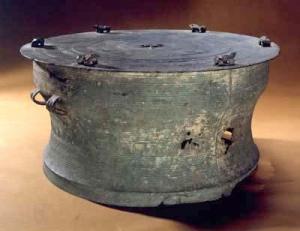1) the use of copper drums


铜鼓使用
1.
This paper is to study the significance of the anthropoloqy of the use of Zhuang and Yao’s drums in the Red River Valley from the oriqinal religion of races incarnating in the use of copper drums of Zhuang and Yao,and from the history racial cultural characteristic elaborating in the use of copper drums.
从壮瑶铜鼓使用所体现的民族原始宗教意识、铜鼓使用所阐释的民族历史文化特征论述红水河流域壮、瑶族铜鼓使用的人类学意义。
2) the use of brass


铜的使用
1.
Or else, maybe they were the compellation for the yellows by the whites and the blacks, while by no means may they came from the use of brass.
"黄帝"名号及黄帝族的名称最初可能来源于:远古时代居住于黄土高原部族的崇谷崇地情结;东方部族对该部族人的蔑称;白色人种与黑色人种对黄色人种的称谓;而不可能来自于铜的使用。
3) Timbal
[英]['timbəl] [美]['tɪmbḷ]


铜鼓
1.
The Influence of the Smelting and Casting Technology's Development of Chinese Bronze on Timbal;
中国青铜冶铸技术发展对铜鼓的影响
2.
Analysis of the chemical composition of the Vietnamese timbal and other objects;


越南铜鼓和其他器物成份分析报告
4) bronze drum


铜鼓
1.
Abundant Concentration of Lead on the Sample of Bronze drum in Viet Nam and Survey for Lead isotopic;
越南铜鼓样品铅的富集与铅同位素测定
2.
The Comparative Study on Tuning Technology Between the Chime and the Bronze Drum in Ancient China;
古代壮族铜鼓与内地铸钟调音技术的比较研究
3.
A large number of ancient bronze drums found in Vietnam provided valuable information for the production technique of bronze drums.
铜鼓在中国和东南亚地区有着悠久的历史,越南发现的大量古代铜鼓,为研究铜鼓的制作技术提供了宝贵的资料。
5) Bronze Drums


铜鼓
1.
Ancient bronze drums symbolized the peak of booming Bronze Age in Southeast Asia,whose trace can still be found in cont.
古代铜鼓代表着东南亚青铜时代繁荣的顶峰,至今在东南亚社会仍可见其踪迹。
2.
In the eight types of bronze drums,Shizhaishan bronze drum has the most elegant and neat decorative lines.
石寨山型铜鼓在八种类型铜鼓中,纹饰最为精美、齐整,艺术风格最为严谨,却又处处彰显写实化、生活化,制作技术也最为精湛。
3.
For more than 2000 years, bronze drums have been the common carrier of culture gradually formed through communication and assimilation of various forms among these countries and peoples.
铜鼓广泛分布于中国南方和与之相邻的越南、老挝、柬埔寨、缅甸、泰国及马来西亚和印度尼西亚等东南亚国家。
6) Brass with use grows bright.


铜器使用才亮。
补充资料:东汉大铜鼓

东汉大铜鼓
铜鼓是一种民族历史文物,它系中国古代南方和西南民族象征财富和权力的重器。一具铜鼓的基本形制有鼓面和鼓身。鼓面是受击部份,鼓身是共鸣腔,由上而下分成胸、腰、足三段,胸腰之间多铸有悬挂用之耳。当前中外学界对铜鼓的研究着重其起源、类型、分布、年代、族属、纹饰、用途、合金成分和铸造工艺等。近年来中国大陆学者以一千四百多面的铜鼓为基础,并据前提重点,作了全面对比研究后,暂将中国古代南方铜鼓分为八型:万家坝型、石寨山型、冷水冲型、遵义型、麻江型、北流型、灵山型和西盟型。以上八型中与此大铜鼓相关者是「北流型」,该型以广西北流县水桶庵的大铜鼓命名,主要分布在广西东南部和广东西南部。铸造和使用年代之上限是西汉晚期,下限至唐代;族属系汉代的乌浒人,晋南朝至隋的俚人。北流鼓的形制特征是
(一)体型硕大。
(二)鼓面大于鼓胸,部份鼓的边沿下折,形成垂檐。
(三)鼓身之胸腰间收缩曲度缓和并铸环耳或肩耳两对,腰足间以一道突棱分界。
(四)鼓面中心的太阳纹凸起鼓面如一圆饼,芒道有六、八、十;鼓面多有立体蛙饰。
(五)鼓面和鼓身多以二或三条突起弦纹为一组分晕,晕圈内多布满精细的模印几何图案,常见者有云纹、雷纹、席纹或钱纹。、
此大铜鼓与北流型的特征大致相符,且可归入该型中期鼓,铸造年代约属东汉晚期。它的整体结构符合美学原理的黄金律标准值,深具完整性和合理性;亦使鼓身在外观上显现匀称、比例适度及谐调。
说明:补充资料仅用于学习参考,请勿用于其它任何用途。